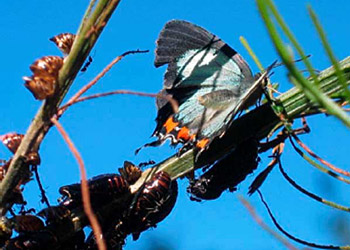
Acacias, Butterflies and Ants
Bill and Noela Jones
Another case for growing feathery-leafed wattles?
A study conducted in 2006 suggested that feathery-leafed (bipinnate) wattles mixed with other understorey species provided small birds with food and a dense structure which deterred aggressive Noisy Miners. They have become a major problem in Sydney because they chase and attack small native birds. For this reason (wattles also make great nurse plants and fix nitrogen) we have planted several different species of feathery-leafed wattles in our garden.
 |
|
 |
Left: Imperial Hairstreak upperside. Right: Imperial Hairstreak, pupae and
attendant ants on Acacia
parramattensis
Photos: Bill and Noela Jones |
Recently, we have enjoyed watching numbers of the Imperial Hairstreak butterfly (or Common Imperial Blue) Jalmenus evagoras on an Acacia parramattensis. This beautiful butterfly is a member of the Blues Family (Lycaenidae). It is a medium-sized butterfly described as common but local with the upperside black and a large metallic greenish-blue central area. The underside is brownish with thin black stripes. The hindwing has a peculiar black "tail" which waves around when the butterfly is walking and looks like the head (maybe to fool predators). The pupae are grouped together and are a shining black colour.
One of the fascinating features of the Blues is the relationship they have with ants. Many lycaenid larvae have mutually benefit relationships. We have observed them swarming all over the larvae and the shining black pupae. The adults fly around the food plant and even when they land, don't seem to mind the ants crawling over them - perhaps because the males are waiting for the females to emerge! The texts even give the genus of the ants (Iridomyrmex).
The adult butterflies feed from flowers of species such as Bursaria. In our garden they have been observed feeding from Synoum glandulosum (scentless rosewood). The Common Brown and Brown Ringlet butterflies have also been seen on this plant. Larval food plants for this butterfly are various acacias, including A. mearnsii, A. decurrens, A. irrorata, A. spectabilis, and A. falcata. Their presence can often be seen at a distance by the damage they cause. Despite resolving that our garden would be a habitat garden, we were tempted to cut off the unsightly pupae when we first spotted them. We are relieved we didn't and the butterflies appeared!
Everyone loves butterflies, perhaps it is their fragility, delicacy and beauty. Butterflies are also important pollinators for many plants. However, most of us don't like the damage caused by the larvae. Endangered butterflies stir the hearts of the public. They possibly could be used more often where development issues occur, e.g. Dr. Michael Braby was able to prevent the building of a shopping centre in outer Melbourne by discovering the presence of the Eltham Copper.
References
1. Braby, M.F. 2004. The Complete Field Guide to Butterflies of Australia. Pp.244-5, CSIRO Publishing.
2. Common, I.F.B. & Waterhouse, D.F. 1981. Butterflies of Australia. p.496-7. Angus & Robertson.
3. Hastings, R.A. & Beattie, J. 2006. Ecological Management & Restoration 7, p.2.
From 'Blandfordia', newsletter of the North Shore Group of the Australian Plants Society (NSW), June 2009.
Australian Plants online - 2009
Australian Native Plants Society (Australia)
|